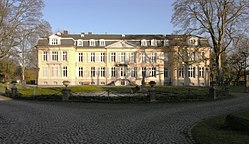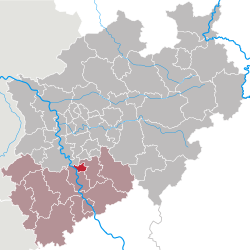Leverkusen
Leverkusen | |
|---|---|
 | |
| Country | Germany |
| State | North Rhine-Westphalia |
| Admin. region | Köln |
| District | Urban district |
| Government | |
| • Mayor | Reinhard Buchhorn (CDU) |
| • Governing parties | CDU / SPD / Bürgerliste |
| Area | |
| • Total | 78.85 km2 (30.44 sq mi) |
| Elevation | 60 m (200 ft) |
| Population (2022-12-31)[1] | |
| • Total | 165,748 |
| • Density | 2,100/km2 (5,400/sq mi) |
| Time zone | UTC+01:00 (CET) |
| • Summer (DST) | UTC+02:00 (CEST) |
| Dialling codes | 0214, 02171 & 02173 |
| Vehicle registration | LEV |
| Website | www.Leverkusen.de/English |
Leverkusen (/ˈleɪvərˌkuːzən/; German pronunciation: [ˈleːvɐˌkuːzn̩]) is a city in North Rhine-Westphalia, Germany on the eastern bank of the Rhine. To the South, Leverkusen borders the city of Cologne and to the North is the state capital Düsseldorf.
With about 161,000 inhabitants, Leverkusen is one of the state's smaller cities. The city is known for the pharmaceutical company Bayer and its associated sports club TSV Bayer 04 Leverkusen.
History
The heart of what is now Leverkusen was a village called Wiesdorf, which dates back to the 12th century. The entire area was rural until the late 19th century, when industry prompted the development that led to the city of Leverkusen, and to its becoming one of the most important centres of the German chemical industry.
The chemist Carl Leverkus, looking to build a dye factory, chose Wiesdorf in 1860. He built a factory for the production of artificial ultramarine blue at the Kahlberg in Wiesdorf in 1861, and called the emerging settlement "Leverkusen" after his family home in Lennep. The factory was taken over by the Bayer company in 1891; Bayer moved its headquarters to Wiesdorf in 1912. After asset confiscation at the end of WWI it became IG Farben. The city of Leverkusen proper was founded in 1930 by merging Wiesdorf, Schlebusch, Steinbüchel and Rheindorf, and was posthumously named for Carl Leverkus. The IG Farben factories were bombed by the USAAF Eighth Air Force on December 1, 1943,[2] by the RAF on August 22, 1943,[3] and by the RAF during bombing campaigns on November 19/20 and December 10/11, 1943.
In 1975, Opladen (including Quettingen and Lützenkirchen since 1930), Hitdorf and Bergisch Neukirchen joined Leverkusen. The present city is made up of several villages, originally called Wiesdorf, Opladen, Schlebusch, Manfort, Bürrig, Hitdorf, Quettingen, Lützenkirchen, Steinbüchel, Rheindorf and Bergisch-Neukirchen.
Main sights and places of interest

- BayArena is the home stadium of Bayer Leverkusen, and seats over 30,000 people.
- The Bayer Cross Leverkusen is one of the largest illuminated advertisements in the world.[citation needed]
- Freudenthaler Sensenhammer is an industrial museum.
- Schloss Morsbroich - moated castle in the baroque style, now a museum for contemporary art.
- Water Tower Leverkusen-Bürrig - 72.45-metre-high (237.7 ft) water reservoir containing an observation deck
- Neuland Park - large park beside the Rhine
- Japanese Garden - A garden created by Carl Duisberg at 1923
- Colony of workers - historical urban district in the center of Leverkusen
- Einigkeit und Recht und Freiheit - historical Boat bridge next to the Rhine between Wiesdorf and Rheindorf
- Mausoleum of Carl Duisberg - mausoleum in the center of the Carl Duisberg Park next to the Casino
- NaturGut Ophoven - educational center for nature in Leverkusen-Opladen
International relations

Leverkusen is twinned with:
|
Notable people
- Jörg Bergmeister (born February 13, 1976), racing driver
- Uta Briesewitz, cinematographer
- Bärbel Dieckmann (born March 26, 1949), politician (SPD), mayor of Bonn 1994-2009
- Paul Janes, football player
- Heidemarie Ecker-Rosendahl (born February 14, 1947), athlete and olympic medalist
- Danny Ecker, athlete, son of Heidemarie Ecker-Rosendahl
- Friedrich Wilhelm Fuchs (June 4, 1902 - April 1, 1990), physicist and former rector of the RWTH Aachen University
- Hans Kühne, plant manager of IG Farben's (Bayer) plant in Leverkusen during World War II, acquitted of crimes against humanity in the IG Farben Trial [9]
- Dietmar Mögenburg, athlete
- Sabine Moussier, telenovela actress
- Ralf Schmitz, (born 1974) actor and comedian
- Detlef Schrempf (born January 21, 1963), former NBA basketball player
- Felix Sturm (born January 31, 1979), middleweight boxer
- Wolf Vostell, painter
- Werner Wenning (born October 21, 1946), former chairman of the board of Bayer AG
- Ji-In Cho (born 30 December 1976), singer of Krypteria
See also
References
- ^ "Bevölkerung der Gemeinden Nordrhein-Westfalens am 31. Dezember 2022 – Fortschreibung des Bevölkerungsstandes auf Basis des Zensus vom 9. Mai 2011" (in German). Landesbetrieb Information und Technik NRW. Retrieved 20 June 2023.
- ^ 322nd Dailies from 1943 - 91st Bomb Group (H). 91st Bomb Group. Retrieved on 2013-07-17.
- ^ WW2 People's War - A Bedfordshire Bomb Aimer - Part Two. BBC. Retrieved on 2013-07-17.
- ^ "Ystävyyskaupungit (Twin Cities)". Oulun kaupunki (City of Oulu) (in Finnish). Retrieved 2013-07-27.
- ^ (Bracknell Town, part of the Bracknell Forest local authority twinned with Opladen in 1973, Opladen then incorporated with Leverkusen in 1975
- ^ "Medmestno in mednarodno sodelovanje". Mestna občina Ljubljana (Ljubljana City) (in Slovenian). Retrieved 2013-07-27.
- ^ Contract in German and Polish
- ^ contract signed(in German)
- ^ "Profit Over Life". The Nuremberg Pharma Tribunal. Retrieved tbd.
{{cite web}}: Check date values in:|accessdate=(help)
Sources
- Blaschke, Stefan (1999): Unternehmen und Gemeinde: Das Bayerwerk im Raum Leverkusen 1891-1914 Cologne: SH-Verlag, ISBN 3-89498-068-0 (German)
- Archive of Leverkusen (2005): Leverkusen. Geschichte einer Stadt am Rhein. Bielefeld: Verlag für Regionalgeschichte, ISBN 3-89534-575-X (German)
- Franz Gruß (1987): Geschichte und Porträt der Stadt Leverkusen. Leverkusen: Verlag Anna Gruß, ISBN 3-930478-03-X (German)




